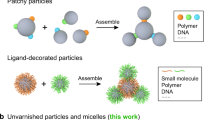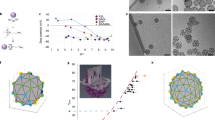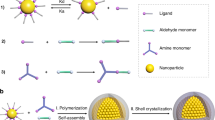Abstract
Colloidal inorganic nanoparticles have size-dependent optical, optoelectronic and material properties that are expected to lead to superstructures with a range of practical applications1,2. Discrete nanoparticles with controlled chemical composition and size distribution are readily synthesized using reverse micelles and microemulsions as confined reaction media3,4,5, but their assembly into well-defined superstructures amenable to practical use remains a difficult and demanding task. This usually requires the initial synthesis of spherical nanoparticles, followed by further processing such as solvent evaporation6,7,8, molecular cross-linking9,10,11,12,13,14 or template-patterning15,16,17,18. Here we report that the interfacial activity of reverse micelles and microemulsions can be exploited to couple nanoparticle synthesis and self-assembly over a range of length scales to produce materials with complex organization arising from the interdigitation of surfactant molecules attached to specific nanoparticle crystal faces. We demonstrate this principle by producing three different barium chromate nanostructures—linear chains, rectangular superlattices and long filaments—as a function of reactant molar ratio, which in turn is controlled by fusing reverse micelles and microemulsion droplets containing fixed concentrations of barium and chromate ions, respectively. If suitable soluble precursors and amphiphiles with headgroups complementary to the crystal surface of the nanoparticle target are available, it should be possible to extend our approach to the facile production of one-dimensional ‘wires’ and higher-order colloidal architectures made of metals and semiconductors.
This is a preview of subscription content, access via your institution
Access options
Subscribe to this journal
Receive 51 print issues and online access
$199.00 per year
only $3.90 per issue
Buy this article
- Purchase on Springer Link
- Instant access to full article PDF
Prices may be subject to local taxes which are calculated during checkout




Similar content being viewed by others
References
Petit,C., Taleb,A. & Pileni,M. P. Self-organization of magnetic nanosized cobalt particles. Adv. Mater. 10, 259–261 (1998).
Taleb,A., Petit,C. & Pileni,M. P. Optical properties of self-assembled 2D and 3D superlattices of silver nanoparticles. J. Phys. Chem. 102, 2214–2220 (1998).
Taleb,A., Petit,C. & Pileni,M. P. Synthesis of highly monodisperse silver nanoparticles from AOT reverse micelles: A way to 2-D and 3-D self-organization. Chem. Mater. 9, 950–959 (1997).
Motte,L., Billoudet,F., Lacaze,E. & Pileni,M. P. Self-organization of size-selected nanoparticles into three-dimensional superlattices. Adv. Mater. 8, 1018–1020 (1996).
Sager,W. F. C. Controlled formation of nanoparticles from microemulsions. Curr. Opin. Colloid Interf. Sci. 3, 276–283 (1998).
Murray,C. B., Kagan,C. R. & Bawendi,M. G. Self-organization of CdSe nanocrystals into three-dimensional quantum dot superlattices. Science 270, 1335–1338 (1995).
Vossmeyer,T. et al. A double-diamond superlattice built-up of Cd17S4(SCH2OH)26 clusters. Science 267, 1476–1479 (1995).
Wang,Z. L. Structural analysis of self-assembling nanocrystal superlattices. Adv. Mater. 10, 13–30 (1998).
Andres,R. P. et al. Self-assembly of a two-dimensional superlattice of molecularly linked metal clusters. Science 273, 1690–1693 (1996).
Brust,M., Bethell,D., Schiffrin,D. J. & Kiely,C. J. Novel gold-dithiol nanonetworks with non-metallic electronic properties. Adv. Mat. 7, 795–797 (1995).
Mirkin,C. A., Letsinger,R. L., Mucic,R. C. & Storhoff,J. J. A DNA-based method for rationally assembling nanoparticles into macroscopic materials. Nature 382, 607–609 (1996).
Alivisatos,A. P. et al. Organization of “nanocrystal molecules” using DNA. Nature 382, 609–611 (1996).
Li,M., Wong,K. K. W. & Mann,S. Organization of inorganic nanoparticles using biotin-streptavidin connectors. Chem. Mater. 11, 23–26 (1999).
Shenton,W., Davis,S. A. & Mann,S. Directed self-assembly of nanoparticles into macroscopic materials using antibody-antigen recognition. Adv. Mater. 11, 449–452 (1999).
Shenton,W., Pum,D., Sleytr,U. B. & Mann,S. Biocrystal templating of CdS superlattices using self-assembled bacterial S-layers. Nature 389, 585–587 (1998).
Dieluweit,S., Pum,D. & Sleytr,U. B. Formation of a gold superlattice on an S-layer with square lattice symmetry. Supramol. Sci. 5, 15–19 (1998).
Davis,S. A., Burkett,S. L., Mendelson,N. H. & Mann,S. Bacterial templating of ordered macrostructures in silica and silica-surfactant mesophases. Nature 385, 420–423 (1997).
Davis,S. A. et al. Brittle bacteria: A biomimetic approach to the formation of fibrous composite materials. Chem. Mater. 10, 2516–2524 (1998).
Hopwood,J. D. & Mann,S. Synthesis of barium sulfate nanoparticles and nanofilaments in reverse micelles and microemulsions. Chem. Mater. 9, 1819–1828 (1997).
Acknowledgements
We thank S. A. Davis for valuable discussions, the University of Bristol for a postgraduate scholarship to M.L., and the Max-Planck Society for financial support to H.S.
Author information
Authors and Affiliations
Corresponding author
Rights and permissions
About this article
Cite this article
Li, M., Schnablegger, H. & Mann, S. Coupled synthesis and self-assembly of nanoparticles to give structures with controlled organization. Nature 402, 393–395 (1999). https://doi.org/10.1038/46509
Received:
Accepted:
Issue Date:
DOI: https://doi.org/10.1038/46509
This article is cited by
-
Biomineralization of bone tissue: calcium phosphate-based inorganics in collagen fibrillar organic matrices
Biomaterials Research (2022)
-
Denary oxide nanoparticles as highly stable catalysts for methane combustion
Nature Catalysis (2021)
-
Water-assisted electrochemical fabrication of Cu/Cu2O nanoparticles in protic ionic liquid and their catalytic activity in the synthesis of quinazolinones
Reaction Kinetics, Mechanisms and Catalysis (2020)
-
Self-assembly of metal–organic polyhedra into supramolecular polymers with intrinsic microporosity
Nature Communications (2018)
-
Computer-aided discovery of a metal–organic framework with superior oxygen uptake
Nature Communications (2018)
Comments
By submitting a comment you agree to abide by our Terms and Community Guidelines. If you find something abusive or that does not comply with our terms or guidelines please flag it as inappropriate.



